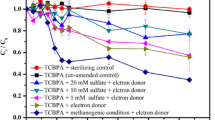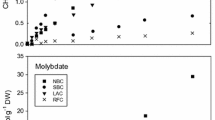Abstract
Estuarine sediment slurries and microorganisms were examined for the ability to methylate inorganic tin. Under controlled redox conditions, tin was methylated only in oxygen-free sediment slurries. Monomethyltin usually comprised greater than 90% of the alkyltin products formed, although dimethyltin was also produced. Autoclaved anoxic sediments did not produce organotins. Several bacterial cultures, most notably sulfate-reducing bacteria isolated from anoxic estuarine sediments, formed monoand dimethyltin from inorganic tin in the absence of sediment. The results suggest that inorganic tin methylation in estuarine environments is an anaerobic process catalyzed primarily by sulfate-reducing microorganisms.
Similar content being viewed by others
References
Ahmad I, Chau YK, Wong PTS, Carty AJ, Taylor L (1980) Chemical alkylation of lead (II) salts to tetraalkyllead (IV) in aqueous solution. Nature 287:716–717
Attramadal A, Svatun B (1983) In vivo antibacterial effect of tin on the oral microflora. Scand J Dental Res 92:161–164
Blair WR, Olson GJ, Brinckman FE, Iverson WP (1982) Accumulation and fate of tri-nbutyltin cation in estuarine bacteria. Microb Ecol 8:241–251
Braman RS, Tompkins MA (1979) Separation and determination of nanogram amounts of inorganic tin and methyltins compounds in the environment. Anal Chem 51:12–20
Buchanan RE, Gibbons NE (eds) (1974) Bergey's manual of determinative bacteriology, 8th ed. Williams and Wilkins Co, Baltimore, Maryland
Byrd JT, Andreae MO (1982) Tin and methyltin species in seawater: concentrations and fluxes. Science 218:565–569
Chau YK, Wong PTS (1978) Occurrence of biological methylation of elements in the environment In: Brinckman FE, Bellama JM (eds) Organometals and organometalloids, occurrence and fate in the environment. American Chemical Society Symposium Series #82, American Chemical Society, Washington, DC, pp 37–51
Chau YK, Wong PTS, Bengert GA (1982) Determination of methyltin (IV) and tin (IV) species in water by gas chromatography/atomic absorption spectrophotometry. Anal Chem 54:246–249
Compeau G, Bartha R (1984) Methylation and demethylation of mercury under controlled redox, pH, and salinity conditions. Appl Environ Microbiol 48:1203–1207
Edwards T, McBride BC (1975) Biosynthesis and degradation of methylmercury in human faeces. Nature 253:462–464
Gilmour CC, Tuttle JH, Means JC (1985) Tin methylation in sulfide-bearing sediments. In: Sigleo AC, Hattori A (eds) Marine and estuarine geochemistry. Lewis Publishers, Chelsea, Michigan, pp 239–258
Guard HE, Cobet AB, Coleman WM III (1981) Methylation of trimethyltin compounds by estuarine sediments. Science 213:770–771
Hallas LE, Cooney JJ (1981) Effects of stannic chloride and organotin compounds on estuarine microorganisms. In: Developments in industrial microbiology, Vol. 22. Society for Industrial Microbiology, pp 529–535
Hallas LE, Means JC, Cooney JJ (1982) Methylation of tin by estuarine organisms. Science 215:1505–1506
Hamdy MK, Noyes OR (1975) Formation of methylmercury by bacteria. Appl Microbiol 30:424–432
Hodge VF, Seidel SL, Goldberg ED (1979) Determination of Sn (IV) and organotin compounds in natural waters, coastal sediments and macro-algae by atomic absorption spectrometry. Anal Chem 51:1256–1259
Hungate RE (1950) The anaerobic mesophilic cellulolytic bacteria. Bact Rev 14:1–19
Ishii T (1982) Tin in marine algae. Bull Jap Soc Sci Fisheries 48:1609–1615
Iverson WP (1966) Growth of desulfovibrio on the surface of agar media. Appl Microbiol 14:529–534
Jackson JA, Blair WR, Brinckman FE, Iverson WP (1982) Gas-chromatographic speciation of methylstannanes in the Chesapeake Bay using purge and trap sampling with a tin-selective detector. Environ Sci Tech 16:110–119
Jarvie AW, Whitemore PAP, Markal RN, Potter HR (1983) The sulphide-assisted decomposition of trimethyl lead chloride in aqueous systems. Environ Pollut (Series B) 6:69–79
Jonas RB, Gilmour CC, Stoner DL, Weir MW, Tuttle JH (1984) Comparison of methods to measure acute metal and organometal toxicity to natural aquatic microbial communities. Appl Environ Microbiol 47:1005–1011
Kudo A, Nagase H, Ose Y (1982) Proportion of methylmercury to the total amount of mercury in river waters in Canada and Japan. Water Res 16:1011–1015
Landner L (1971) Biochemical model for the biological methylation of mercury suggested from methylation studies in vivo withNeurospora crassa. Nature 230:452–454
Lewis RJ, Tatken RL (eds) (1979) Registry of the toxic effects of chemical substances. National Institutes for Occupational Safety and Health, Cincinnati, Ohio
Means JC, Hulebak KL (1983) A methodology for speciation of methyltins in mammalian tissue. NeuroToxicology 4:37–44
Noland, EA, Taylor DH, Bull RJ (1982) Monomethyl and trimethyltin compounds induce learning deficiencies in young rats. Neurobehavior Toxicol Teratol 4:539–544
Officer CB, Biggs RB, Taft JL, Cronin LE, Tyler MA, Boynton WR (1984) Chesapeake Bay anoxia: origin, development, and significance. Science 223:22–27
Olson B, Barkay T, Nies D, Bellama JM, Colwell RR (1979) Plasmid mediation of mercury volatilization and methylation by estuarine bacteria. In: Developments in industrial microbiology, Vol. 20. Society for Industrial Microbiology, pp 275–284
Postgate J (1965) Enrichment and isolation of sulphate-reducing bacteria. In: Schlegel HG, Kroger E (eds) Anreicherungskultur und Mutantenauslese. Fischer, Stuttgart, pp 190–196
Ridley WP, Dizikes LJ, Wood JM (1977) Biomethylation of toxic elements in the environment. Science 197:329–332
Rowland IR, Davies MJ, Grasso P (1977) Volatilisation of methylmercuric chloride by hydrogen sulphide. Nature 265:718–719
Tugrul S, Balkas TI, Goldberg E (1983) Methyltins in the marine environment. Marine Poll Bull 14:297–303
Van Der Kirk GJM, Luijten JGA (1954) Investigations of organo-tin compounds. III. The biocidal properties of organo-tin compounds. J Appl Chem 1954:314–319
Vonk JW, Sijpesteijn AK (1973) Studies on the methylation of mercuric chloride by pure cultures of bacteria and fungi. Antonie van Leeuwenhoek 39:503–513
Wood JM (1974) Biological cycles for toxic elements in the environment. Science 183:1049–1052
Wood JM, Kennedy FS, Rosen CG (1968) Synthesis of methylmercury compounds by extracts of a methanogenic bacteria. Nature 220:173–174
Yamada M, Tonomura K (1972) Formation of methylmercury compounds from inorganic mercury byClostridium cochlearium. J Ferment Tech 50:159–166
Zuckerman JJ, Residorf RP, Ellis HV III, Wilkinson RR (1978) Organotins in biology and the environment. In: Brinckman FE, Bellama JM (eds) Organometals and organometalloids, occurrence and fate in the environment. American Chemical Society, Washington, DC, pp 388–422
Author information
Authors and Affiliations
Rights and permissions
About this article
Cite this article
Gilmour, C.C., Tuttle, J.H. & Means, J.C. Anaerobic microbial methylation of inorganic tin in estuarine sediment slurries. Microb Ecol 14, 233–242 (1987). https://doi.org/10.1007/BF02012943
Issue Date:
DOI: https://doi.org/10.1007/BF02012943




